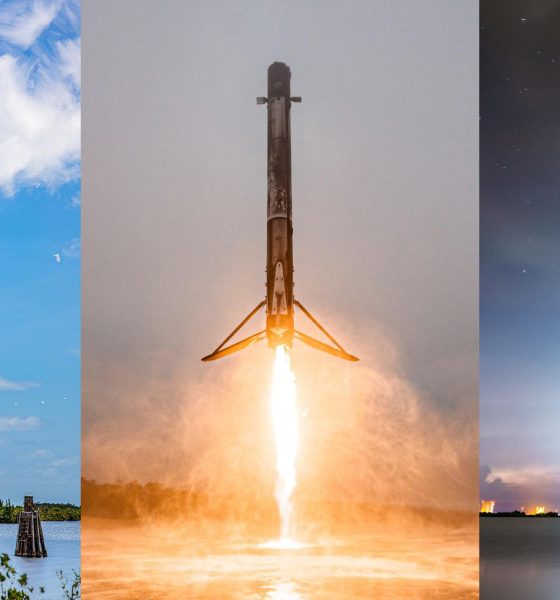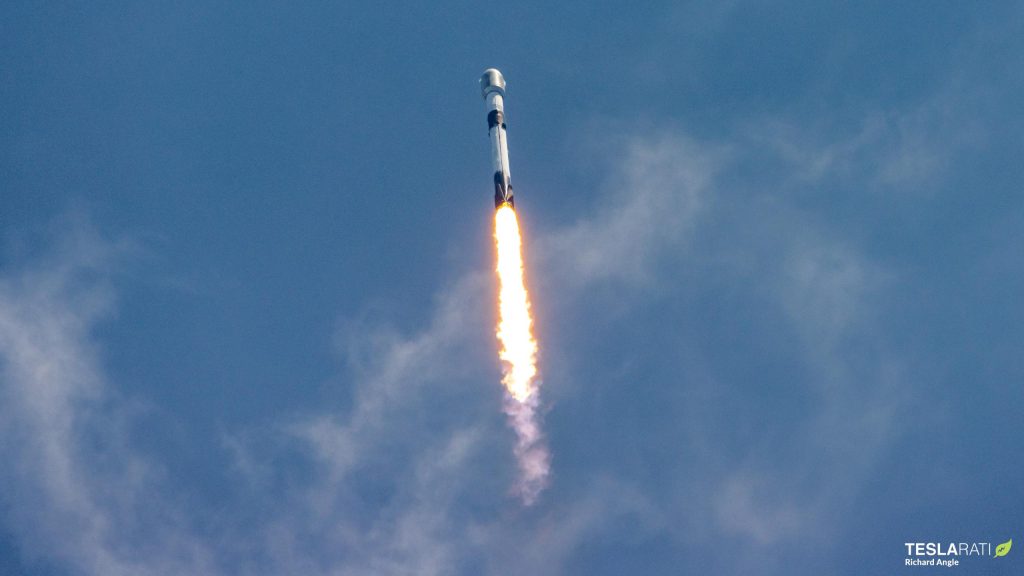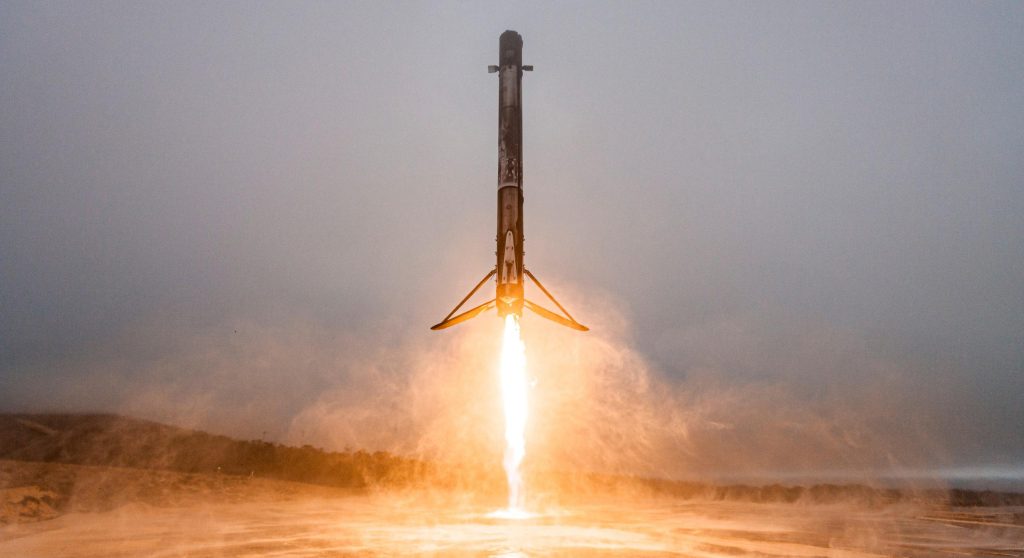

News
SpaceX launches three Falcon 9 rockets in 36 hours
SpaceX has successfully completed three Falcon 9 launches in just over 36 hours, highlighting the company’s continuous push towards ever-higher launch cadences in 2022.
In February, shortly after a NASA oversight panelist revealed that SpaceX was targeting 52 launches in 2022, CEO Elon Musk confirmed that the company’s goal was for “Falcon [to] launch about once a week” throughout the year. In October 2020, continuing a tradition of extremely ambitious SpaceX launch cadence targets, Musk had also tweeted that “a lot of improvements” would need to be made to achieve his goal of 48 launches – an average of four launches per month – in 2021. Ultimately, SpaceX fell well short of that target, but did set a new annual record of 31 launches in one year, breaking its 2020 record of 26 launches by about 20%. However, perhaps even more important than the new record was the fact that SpaceX was able to complete six launches in four weeks at the end of 2021.
That impressive and unexpected achievement would turn out to be an explicit sign of things to come in 2022.
SpaceX’s successful completion of three launches in 36.5 hours is merely an extension of that feat. In the same four-week period at the end of 2021, SpaceX completed three of those six launches in 69 hours. Two months later, SpaceX did it again, launching three Falcon 9 rockets from all three of its Falcon launch pads in 67 hours.
More importantly, SpaceX has also managed to sustain an average cadence of more than one Falcon launch per week throughout the first half of 2022, completing its 26th launch of the year on June 19th with another two launches planned before the end of the month. SpaceX has actually sustained that cadence for even longer. Beginning on November 24th, 2021, SpaceX has now completed 32 Falcon 9 launches in less than seven months.
The company’s latest hat-trick or triple-header began on Friday, June 17th, when Falcon 9 booster B1060 lifted off at 12:09 pm EDT from SpaceX’s NASA Kennedy Space Center LC-39A pad, helped carry another 53 Starlink V1.5 satellites into space, and became the first Falcon booster to launch and land 13 times. Starlink 4-19 was also SpaceX’s 49th dedicated Starlink launch, SpaceX’s 50th consecutively successful Falcon booster landing, and 100th successful Falcon booster reuse.

22 hours later, a second Falcon 9 rocket lifted off from SpaceX’s Vandenberg Space Force Base SLC-4E pad at 7:19 am PDT, Saturday, June 18th carrying the first of three SARah radar satellites for Germany and an unspecified number of rideshare payloads. For the third time this year, booster B1071 successfully boosted back to shore and touched down at SLC-4E’s LZ-4 landing pad shortly after liftoff.

Finally, at 12:27 am EDT on Sunday, June 19th, a third Falcon 9 rocket lifted off from SpaceX’s Cape Canaveral Space Force Station LC-40 pad carrying a single spare Globalstar-2 communications satellite and, apparently, several secret rideshare payloads. Falcon 9’s Globalstar launch occurred just over 14 hours after SARah-1, breaking SpaceX’s record time between two orbital launches.

Globalstar FM15 was also SpaceX’s 26th launch of 2022, averaging one launch every 6.5 days in the first half of the year. June isn’t over, however, and SpaceX still has plans to launch Starlink 4-21 on June 25th and the SES-22 geostationary communications satellite on June 28th. If both launches avoid delays, SpaceX will end the first half of 2022 with 28 successful orbital launches. Perhaps even more significantly, after another two launches in the last days of June, SpaceX will have launched 17 times in a single quarter – equivalent to 68 launches per year if sustained for four quarters. In the history of spaceflight, a single rocket family has never successfully launched more than 61 times in one year.

News
Tesla aims to combat common Full Self-Driving problem with new patent
Tesla writes in the patent that its autonomous and semi-autonomous vehicles are heavily reliant on camera systems to navigate and interact with their environment.

Tesla is aiming to combat a common Full Self-Driving problem with a new patent.
One issue with Tesla’s vision-based approach is that sunlight glare can become a troublesome element of everyday travel. Full Self-Driving is certainly an amazing technology, but there are still things Tesla is aiming to figure out with its development.
Unfortunately, it is extremely difficult to get around this issue, and even humans need ways to combat it when they’re driving, as we commonly use sunglasses or sun visors to give us better visibility.
Cameras obviously do not have these ways to fight sunglare, but a new patent Tesla recently had published aims to fight this through a “glare shield.”
Tesla writes in the patent that its autonomous and semi-autonomous vehicles are heavily reliant on camera systems to navigate and interact with their environment.

The ability to see surroundings is crucial for accurate performance, and glare is one element of interference that has yet to be confronted.
Tesla described the patent, which will utilize “a textured surface composed of an array of micro-cones, or cone-shaped formations, which serve to scatter incident light in various directions, thereby reducing glare and improving camera vision.”

The patent was first spotted by Not a Tesla App.
The design of the micro-cones is the first element of the puzzle to fight the excess glare. The patent says they are “optimized in size, angle, and orientation to minimize Total Hemispherical Reflectance (THR) and reflection penalty, enhancing the camera’s ability to accurately interpret visual data.”
Additionally, there is an electromechanical system for dynamic orientation adjustment, which will allow the micro-cones to move based on the angle of external light sources.
This is not the only thing Tesla is mulling to resolve issues with sunlight glare, as it has also worked on two other ways to combat the problem. One thing the company has discussed is a direct photon count.
CEO Elon Musk said during the Q2 Earnings Call:
“We use an approach which is direct photon count. When you see a processed image, so the image that goes from the sort of photon counter — the silicon photon counter — that then goes through a digital signal processor or image signal processor, that’s normally what happens. And then the image that you see looks all washed out, because if you point the camera at the sun, the post-processing of the photon counting washes things out.”
Future Hardware iterations, like Hardware 5 and Hardware 6, could also integrate better solutions for the sunglare issue, such as neutral density filters or heated lenses, aiming to solve glare more effectively.
Elon Musk
Delaware Supreme Court reinstates Elon Musk’s 2018 Tesla CEO pay package
The unanimous decision criticized the prior total rescission as “improper and inequitable,” arguing that it left Musk uncompensated for six years of transformative leadership at Tesla.

The Delaware Supreme Court has overturned a lower court ruling, reinstating Elon Musk’s 2018 compensation package originally valued at $56 billion but now worth approximately $139 billion due to Tesla’s soaring stock price.
The unanimous decision criticized the prior total rescission as “improper and inequitable,” arguing that it left Musk uncompensated for six years of transformative leadership at Tesla. Musk quickly celebrated the outcome on X, stating that he felt “vindicated.” He also shared his gratitude to TSLA shareholders.
Delaware Supreme Court makes a decision
In a 49-page ruling Friday, the Delaware Supreme Court reversed Chancellor Kathaleen McCormick’s 2024 decision that voided the 2018 package over alleged board conflicts and inadequate shareholder disclosures. The high court acknowledged varying views on liability but agreed rescission was excessive, stating it “leaves Musk uncompensated for his time and efforts over a period of six years.”
The 2018 plan granted Musk options on about 304 million shares upon hitting aggressive milestones, all of which were achieved ahead of time. Shareholders overwhelmingly approved it initially in 2018 and ratified it once again in 2024 after the Delaware lower court struck it down. The case against Musk’s 2018 pay package was filed by plaintiff Richard Tornetta, who held just nine shares when the compensation plan was approved.
A hard-fought victory
As noted in a Reuters report, Tesla’s win avoids a potential $26 billion earnings hit from replacing the award at current prices. Tesla, now Texas-incorporated, had hedged with interim plans, including a November 2025 shareholder-approved package potentially worth $878 billion tied to Robotaxi and Optimus goals and other extremely aggressive operational milestones.
The saga surrounding Elon Musk’s 2018 pay package ultimately damaged Delaware’s corporate appeal, prompting a number of high-profile firms, such as Dropbox, Roblox, Trade Desk, and Coinbase, to follow Tesla’s exodus out of the state. What added more fuel to the issue was the fact that Tornetta’s legal team, following the lower court’s 2024 decision, demanded a fee request of more than $5.1 billion worth of TSLA stock, which was equal to an hourly rate of over $200,000.
Delaware Supreme Court Elon Musk 2018 Pay Package by Simon Alvarez
News
Tesla Cybercab tests are going on overdrive with production-ready units
Tesla is ramping its real-world tests of the Cybercab, with multiple sightings of the vehicle being reported across social media this week.

Tesla is ramping its real-world tests of the Cybercab, with multiple sightings of the autonomous two-seater being reported across social media this week. Based on videos of the vehicle that have been shared online, it appears that Cybercab tests are underway across multiple states.
Recent Cybercab sightings
Reports of Cybercab tests have ramped this week, with a vehicle that looked like a production-ready prototype being spotted at Apple’s Visitor Center in California. The vehicle in this sighting was interesting as it was equipped with a steering wheel. The vehicle also featured some changes to the design of its brake lights.
The Cybercab was also filmed testing at the Fremont factory’s test track, which also seemed to involve a vehicle that looked production-ready. This also seemed to be the case for a Cybercab that was spotted in Austin, Texas, which happened to be undergoing real-world tests. Overall, these sightings suggest that Cybercab testing is fully underway, and the vehicle is really moving towards production.
Production design all but finalized?
Recently, a near-production-ready Cybercab was showcased at Tesla’s Santana Row showroom in San Jose. The vehicle was equipped with frameless windows, dual windshield wipers, powered butterfly door struts, an extended front splitter, an updated lightbar, new wheel covers, and a license plate bracket. Interior updates include redesigned dash/door panels, refined seats with center cupholders, updated carpet, and what appeared to be improved legroom.
There seems to be a pretty good chance that the Cybercab’s design has been all but finalized, at least considering Elon Musk’s comments at the 2025 Annual Shareholder Meeting. During the event, Musk confirmed that the vehicle will enter production around April 2026, and its production targets will be quite ambitious.








